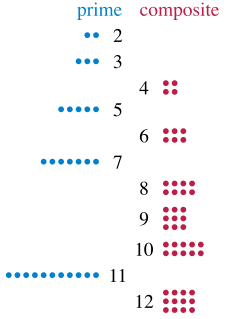
Arithmetic is a branch of mathematics that consists of the study of numbers, especially the properties of the traditional operations on them—addition, subtraction, multiplication, division, exponentiation and extraction of roots. Arithmetic is an elementary part of number theory, and number theory is considered to be one of the top-level divisions of modern mathematics, along with algebra, geometry, and analysis. The terms arithmetic and higher arithmetic were used until the beginning of the 20th century as synonyms for number theory, and are sometimes still used to refer to a wider part of number theory.
The duodecimal system is a positional notation numeral system using twelve as its base. The number twelve is instead written as "10" in duodecimal, whereas the digit string "12" means "1 dozen and 2 units". Similarly, in duodecimal "100" means "1 gross", "1000" means "1 great gross", and "0.1" means "1 twelfth".
In mathematics, a Mersenne prime is a prime number that is one less than a power of two. That is, it is a prime number of the form Mn = 2n − 1 for some integer n. They are named after Marin Mersenne, a French Minim friar, who studied them in the early 17th century. If n is a composite number then so is 2n − 1. Therefore, an equivalent definition of the Mersenne primes is that they are the prime numbers of the form Mp = 2p − 1 for some prime p.

A number is a mathematical object used to count, measure, and label. The original examples are the natural numbers 1, 2, 3, 4, and so forth. Numbers can be represented in language with number words. More universally, individual numbers can be represented by symbols, called numerals; for example, "5" is a numeral that represents the number five. As only a relatively small number of symbols can be memorized, basic numerals are commonly organized in a numeral system, which is an organized way to represent any number. The most common numeral system is the Hindu–Arabic numeral system, which allows for the representation of any number using a combination of ten fundamental numeric symbols, called digits. In addition to their use in counting and measuring, numerals are often used for labels, for ordering, and for codes. In common usage, a numeral is not clearly distinguished from the number that it represents.

A prime number is a natural number greater than 1 that is not a product of two smaller natural numbers. A natural number greater than 1 that is not prime is called a composite number. For example, 5 is prime because the only ways of writing it as a product, 1 × 5 or 5 × 1, involve 5 itself. However, 4 is composite because it is a product in which both numbers are smaller than 4. Primes are central in number theory because of the fundamental theorem of arithmetic: every natural number greater than 1 is either a prime itself or can be factorized as a product of primes that is unique up to their order.
A palindromic number is a number that remains the same when its digits are reversed. In other words, it has reflectional symmetry across a vertical axis. The term palindromic is derived from palindrome, which refers to a word whose spelling is unchanged when its letters are reversed. The first 30 palindromic numbers are:
7 (seven) is the natural number following 6 and preceding 8. It is the only prime number preceding a cube, and is often considered lucky in Western culture, and is often seen as highly symbolic.
In recreational mathematics, a repunit is a number like 11, 111, or 1111 that contains only the digit 1 — a more specific type of repdigit. The term stands for repeated unit and was coined in 1966 by Albert H. Beiler in his book Recreations in the Theory of Numbers.
In recreational mathematics, a repdigit or sometimes monodigit is a natural number composed of repeated instances of the same digit in a positional number system. The word is a portmanteau of repeated and digit. Examples are 11, 666, 4444, and 999999. All repdigits are palindromic numbers and are multiples of repunits. Other well-known repdigits include the repunit primes and in particular the Mersenne primes.
In mathematics and digital electronics, a binary number is a number expressed in the base-2 numeral system or binary numeral system, which uses only two symbols: typically "0" (zero) and "1" (one).
In arithmetic, long division is a standard division algorithm suitable for dividing multi-digit numbers that is simple enough to perform by hand. It breaks down a division problem into a series of easier steps.
53 (fifty-three) is the natural number following 52 and preceding 54. It is the 16th prime number.
In mathematics, a palindromic prime is a prime number that is also a palindromic number. Palindromicity depends on the base of the number system and its notational conventions, while primality is independent of such concerns. The first few decimal palindromic primes are:

Positional notation denotes usually the extension to any base of the Hindu–Arabic numeral system. More generally, a positional system is a numeral system in which the contribution of a digit to the value of a number is the value of the digit multiplied by a factor determined by the position of the digit. In early numeral systems, such as Roman numerals, a digit has only one value: I means one, X means ten and C a hundred. In modern positional systems, such as the decimal system, the position of the digit means that its value must be multiplied by some value: in 555, the three identical symbols represent five hundreds, five tens, and five units, respectively, due to their different positions in the digit string.
100,000 (one hundred thousand) is the natural number following 99,999 and preceding 100,001. In scientific notation, it is written as 105.
A dihedral prime or dihedral calculator prime is a prime number that still reads like itself or another prime number when read in a seven-segment display, regardless of orientation, and surface. The first few decimal dihedral primes are
An n-parasitic number is a positive natural number which can be multiplied by n by moving the rightmost digit of its decimal representation to the front. Here n is itself a single-digit positive natural number. In other words, the decimal representation undergoes a right circular shift by one place. For example, 4•128205=512820, so 128205 is 4-parasitic. Most authors do not allow leading zeros to be used, and this article follows that convention. So even though 4•025641=102564, the number 025641 is not 4-parasitic.
In number theory, a left-truncatable prime is a prime number which, in a given base, contains no 0, and if the leading ("left") digit is successively removed, then all resulting numbers are prime. For example, 9137, since 9137, 137, 37 and 7 are all prime. Decimal representation is often assumed and always used in this article.
A repeating decimal or recurring decimal is decimal representation of a number whose digits are periodic and the infinitely repeated portion is not zero. It can be shown that a number is rational if and only if its decimal representation is repeating or terminating. For example, the decimal representation of 1/3 becomes periodic just after the decimal point, repeating the single digit "3" forever, i.e. 0.333.... A more complicated example is 3227/555, whose decimal becomes periodic at the second digit following the decimal point and then repeats the sequence "144" forever, i.e. 5.8144144144.... At present, there is no single universally accepted notation or phrasing for repeating decimals.
The digits of some specific integers permute or shift cyclically when they are multiplied by a number n. Examples are:



